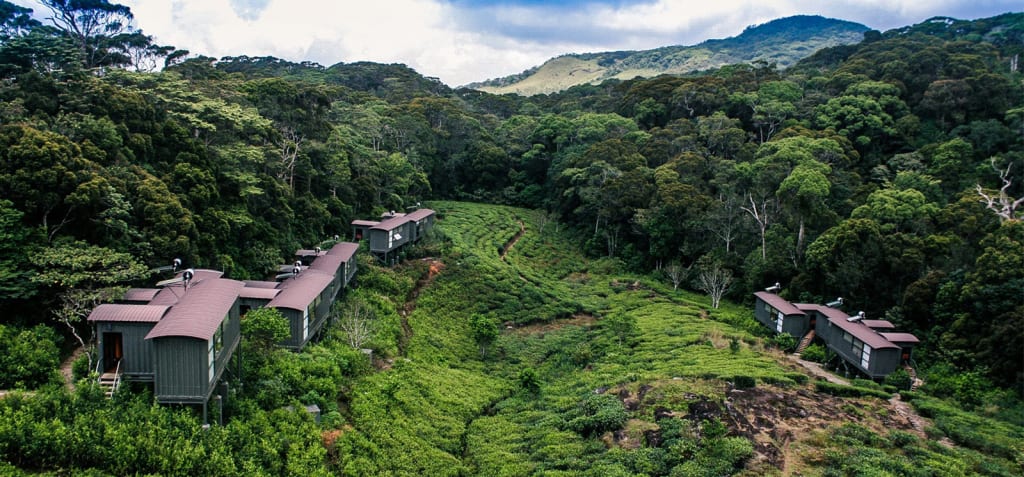
In the southern and Sabaragamuwa provinces of Sri Lanka, in the south-west lowland wet zone, is Sinharaja, a rain forest and a hotspot for biodiversity. The country's only remaining primary tropical rain forest is located in Sinharaja. The word "Sinharaja" means "Lion King" in English. 11,000 hectares of primary and secondary woods are present there. This short stretch of hilly terrain is made up of several hills and valleys. According to the International Union for Conservation of Nature, Sinharaja is the final tract of primary tropical rainforest left in the nation (IUCN). More than 60% of the trees in Sinharaja Forest are native to the area, and many of them are unique. There is a lot of endemic wildlife in the reserve, particularly birds, but there are also many different kinds of insects, reptiles, and uncommon amphibians, as well as over 50% of Sri Lanka's endemic butterfly and mammal species. This is one of the key causes behind UNESCO's 1988 declaration of Sinharaja Forest Reserve as a UNESCO World Heritage Site. Sinharaja Forest was initially identified in 1936 as the Island's sole sizable area of natural tropical rain forest.
In 1978, UNESCO approved Sinharaja Forest as a Biosphere Reserve. The location is close to being designated as a National Heritage Wilderness Area in recognition of the necessity for the utmost amount of protection. being a home to rare and endangered species and a premier location for research on biological evolution the finest spot to view mixed species bird flocks is in Sinharaja Forest. Research on mixed-species bird flocks found that, on average, there are 42 unique birds in each flock, making this the largest mixed-species bird flock in the whole globe. Since it began in 1981, the mixed species bird flock research in the Sinharaja forest has been regarded as the longest in the entire world.
The last significant area of primary lowland rainforest in Sri Lanka is found in Sinharaja Forest Reserve, which is situated in the southwest lowland wet zone of the island nation. Its 8,864 hectares are made up of 2,772 hectares of proposed forest reserve and 6,092 hectares of forest reserve, with an elevation range of 300 to 1,170 meters. A number of peaks and valleys are interspersed across this small area of undulating landscape, and they are joined by a complex web of waterways. This complex system of rivers empties into the Gin River on the property's southern border and the Kalu River on its northern border through the Napola Dola, Koskulana Ganga, and Kudawa Ganga. Over the past 60 years, annual rainfall has varied from 3614 to 5006 mm.
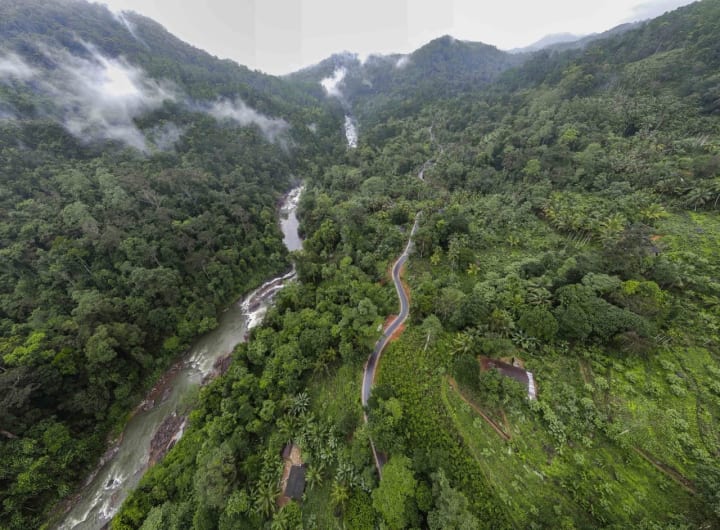
Endemic Species
There are 830 endemic species in Sri Lanka, 217 of which are trees and woody climbers found in the low land wet zone. 16 rare species are among the 139 (64%) that have been found in the reserve. 19 (95%) of the 20 species of birds reported on the property are indigenous to Sri Lanka, demonstrating the high level of faunal endemism in this group. Mammals and butterflies both have endemism rates above 50%. The reserve is home to several vulnerable, endangered, and uncommon species, including the leopard, Indian elephant, Sri Lankan wood pigeon, green-billed coucal, Sri Lankan white-headed starling, Sri Lankan blue magpie, ashy-headed babbler, and Sri Lanka broad-billed roller.
Birdwatchers can witness about 21 of the 33 indigenous bird species when visiting Sinharaja, while there are actually more endemic bird species reported there.

For the greatest access to Sinharaja's top birding spots, where a variety of bird species congregate, use the former logging roads which include Orange- billed Babbler, Crested Drongo, Red faced Malkoha, Ashy headed Laughing Thrush, Green billed Coucal, Lesser Yellow nape, Orange Minivet, Indian Scimitar Babbler, Black napped 5 Monarch, Yellow fronted Barbet, White faced Starling, Sri Lanka Spur fowl, Yellow browed Bulbul, Bronze winged Pigeon, Spot winged Thrush, Sri Lanka Myna, Legge’s Flowerpecker, Brown backed Needle tail, Green Imperial Pigeon, Sri Lanka Blue Magpie, Chestnut backed Owlet, Sri Lanka Frogmouth, Sealy Thrush, Sri Lanka Hanging Parrot, Black- throated Munia, Layard’s Parakeet, Black Eagle, Crested Goshawk, Dark fronted Babbler and Velvut fronted Nuthatch, As the dusk falls you could look for the sub continental endemic Sri Lanka Frogmouth.
Climate
Sinharaja experiences a yearly temperature of around 23.6 °C. It is located within the 3810–5080mm isohyets and gets more than 2500mm of rain yearly. The amount of precipitation is evenly distributed at peak times, with the bulk occurring between May and July and September and November during the south-west and north-east monsoons, respectively (November- January).
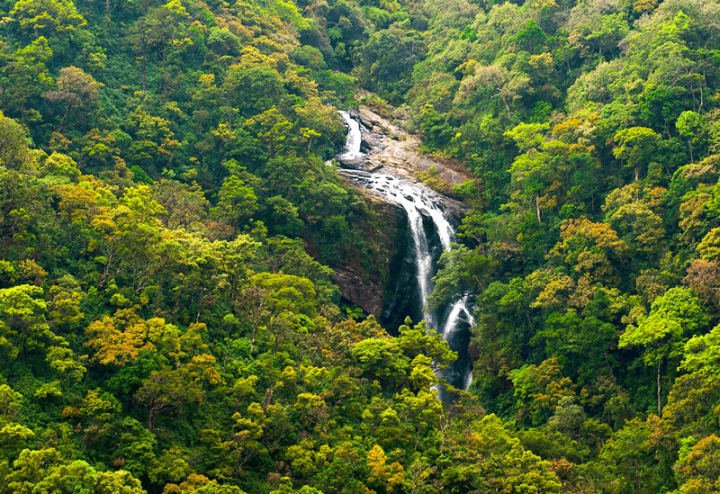
Topography
The Sinharaja Reserve is 200 to 1300 meters above sea level. A succession of peaks and valleys make up the reserve's undulating landscape, which acquires an east-west pattern in the north-western portion. The peaks and valleys take on a North-West/South-East pattern in other areas of the reserve. The highest point is Hinipitigala's summit, which rises up to roughly 1150m. Other significant ridges in the reserve are Moulawella (760m), Kosgulana (797m), Sinhagala (742m), Kohilearambe (575m), Dotalugala (769m), and Tibbottagala, which range in height from 550 to 800m (904m).
Geology & Soil
The Sinharaja Reserve is located in a zone that separates two significant rock types: the South/Western Group, which consists of metasediments such as charnockites and scapolite bearing calcium granulite, and the Highland Group, which consists of charnockites and khondalites of metamorphosed sediments. The "Sinharaja Basic Zone," which includes hornblende pyroclasts, basic charnockites, pyroxene amphibolites, and scapolite, is the most notable geological feature of Sinharaja.
The majority of the soil of Sinharaja is a Red Yellow Podzolic soil, with distinct horizons of variable soil depth. The soil test revealed that it had good drainage and very little organic matter buildup.

Animal Life
According to preliminary research on Sinharaja's flora, butterflies, fish, amphibians, reptiles, birds, and mammals exhibit a significant degree of endemism. In actuality, Sinharaja has records of 95% of the endemic birds in Sri Lanka. Mammals and butterflies both have endemism rates above 50%.
Elephant sightings have not been reported in the previous 15 years, despite the fact that they were once thought to be abundant among the bigger species. There have been rumors of a few creatures being sighted in the Eastern Sector, though. The sambar is the most prevalent kind of deer. The reserve also contains mouse-deer and barking deer. Although leopards are extremely seldom seen, their regular existence has been demonstrated by footprints and other clues. There have been sporadic sightings of the golden-palm civet and the brown mongoose. The purple-faced leaf monkey is the primate that is most frequently sighted.

72% of the birds found in the reserve's Western portion were resident non-endemics, and 13% were migratory birds. The presence of mixed species foraging bird groups, a phenomenon frequently observed in rainforests, is one of the most fascinating and colorful spectacles to be found in the Sinharaja. Studies have shown that some of the 100 such flocks that were carefully monitored had 48 species, including 12 endemic species. The red-faced malkoha, the Sri Lanka blue magpie, the ashy-headed babbler, the white-headed starling, and the green-billed coucal the rarest of Sri Lankan birds are among the rare endemic species to be found in Sinharaja.
The category of reptiles with the greatest representation is the agamids, with the Green Garden Lizard being the most prevalent. Sightings of the rarest agamid on the island, Calotes liolepis, are of particular note. The hard-shelled terrapin is the sole turtle found in the reserve, while the spotted skink is the most common type of skink. The green pit viper and hump-nosed viper, two indigenous snakes of Sri Lanka, are frequently seen in this area.
Nine indigenous species of amphibians have been found, and they are all pretty well represented in the reserve. the common house toad and the endemic Torrent toad. The Wrinkled frog and the Sri Lanka Reed frog are both common in Sinharaja's streams and marshes. The sole known microhylid is the uncommon endemic species Ramanella palmata, whereas the only known apodan is the yellow-banded Caecilian.
Plant Life
Sinharaja's vegetation may be classified as either a tropical lowland rain forest or a tropical wet evergreen forest. The loftiness of the main trees, the straightness of their bole, the amount of regeneration, and the variety of species are some notable features of the forest.
The trees range in height from 35 to 40 meters on average. Some people can climb up to 50 meters.

Contrary to common opinion, scrub growth does happen on rock ledges or cracks in the canopy caused by mature trees collapsing. Ecological trends in the Sinharaja forest are difficult to detect due to the high species variety. However, several tree associations have been identified. These include the Mesua-Doona (Shorea) association, which serves as the structural foundation of the Sinharaja forest, and the Dipterocarpus (Hora-Bu Hora), which is restricted to the lower altitudes of the Gin Ganga river.
Sinharaja has a humid, moist evergreen forest type of vegetation with a significant amount of endemism. In reality, endemism in certain families, as that in the Dipterocarpaceae, exceeds 90%. The genetic potential of Sinharaja flora is woefully underutilized. 139 (66%) of the 211 woody trees and lianas that have been discovered so far within the reserve are endemic. Similar to this, lesser plants like ferns and epiphytes may also exhibit significant degrees of endemism. 13 of Sri Lanka's 25 general endemics are represented in Sinharaja.
According to estimates, there are over 240,000 people per hectare of vegetation, including trees, shrubs, herbs, and seedlings, 95% of which are found in the ground layer beneath one meter in height. The density of trees, lianas above 30 cm girth at breast height, ranges between 600-700 individuals/ hectare. While the number of merchantable individuals of trees of girth greater than 150 cm. Ranges between 45-55 individuals/hectare.
People
There are 22 villages around Sinharaja, each having a population of about 5000. The reserve only contains the two settlements of Warukandeniya and Kolonthotuwa. In reality, the challenge of maintaining and protecting the forest is made more difficult by the lengthy history of human occupation in and around the current reserve. A handful are placed on the north-western edge, while the most of the old structures are found along the reserve's southern perimeter on the bank of the Gin Ganga. There are three routes that span the interior of the forest, while there are several historic footpaths on the reserve's perimeter.
Parents, kids, and grandparents all reside together, creating an extended family structure. The homes are made of wattle and daub and have a tiny, average floor size of 25 square meters. The ceiling is covered in bamboo leaves or the leaves of the Beru tree, a small forest species. Clay tiles and coconut leaves for thatching have recently gained appeal as roofing materials, nevertheless.

Rice is the primary food source for the inhabitants. Yams produced in backyard gardens are frequently utilized as alternatives for rice, including sweet potato, manioc (Cassawa), breadfruit, and jackfruit. Black pepper, passion fruit, and vines of betel (Piper betel) are additional plants that are frequently seen in household gardens. Banana and papaya plants are also cultivated. The majority of the residents' other requirements are met by plants frequently found in the forest. Florence is where the Kitul palm is harvested for the sap required to make jaggery (Caryota urens).
The production of rattan baskets and mats on "wewal" is another source of revenue. The people also utilize wild cardamom and resinous exudates from other shorea species, such as Nawada (Shorea stipularis), as fumigating agents.
Exudates from the Kekuna (Canarium zelanicum) plant are used as adhesive and caulk for household projects. The stem of Weniwel (Coscinium fenestratum), which is utilized by the majority of Sri Lankans as a tetanus antidote, is of particular relevance. Many other plants used in the ancient "ayurvedic" system of medicine are also harvested and sold by the villagers. Fruit from the Beraliya (Shorea megistophylla) is frequently used as a flour replacement.
The reality is that, to the villager, the forest is an easily available storehouse of riches that is ready to be exploited, despite recent research showing that people do not rely on it as their major source of income in Sinharaja 3. The majority of residents are underprivileged and frequently have big families. Their schooling is not very high. Additionally, there aren't many industrial firms or other work prospects in the area. Therefore, it is not strange that it belongs to them and serves as a location that might provide a means of subsistence.

Maha Hedaya – A medicinal Plant
The unique characteristic of Sinharaja described above demonstrates the vital need of preserving its biological variety and gene pool. The significance of this area as a priceless watershed is another factor that is intimately related to the preservation of Sinharaja. The preservation of Sinharaja will not only guarantee the upkeep of water supplies but also lessen the intensity of floods, which are a continual hazard in this region of the island, which is known for receiving a lot of rain. The Sinharaja Forest Reserve is directly under the control of the Sri Lankan Forest Department; it is completely protected and administered primarily as a rare genepool and watershed. You forest visitors should be aware of the importance of protecting forests like Sinharaja. Contrary to the disorder and congestion that characterize metropolitan areas, the quality of life is best exhibited in woods. Man, also finds quiet and tranquillity in forests. Regardless of whether you are a photographer, artist, scientist, or someone who simply appreciates nature, give yourself enough time to wander about in this verdant cathedral of nature and take in its beauty and majesty.
The Senkanda Cave
In this rock cave, a hermit by the name of Senkanda resided. In this jungle, someone once went in search of rattan but ended up getting lost. This destitute peasant was welcomed by the hermit, who let him stay the night in his cave. The man saw many lovely things taking place in the jungle. Villager Wickramabahu, whose kingdom was then centered at Gampola, was informed of the further facts about the forest by the hermit. When an adversary later attached his realm, the monarch escaped and took refuge in that rock cave. The monarch then constructs his realm within this jungle.
Kodimale
Among several smaller peaks within the forest, this one is the tallest. The national flag and religious flags are said to have flown atop this summit in the distant past. This summit rises around 800 feet above mean sea level.
Pus Wela
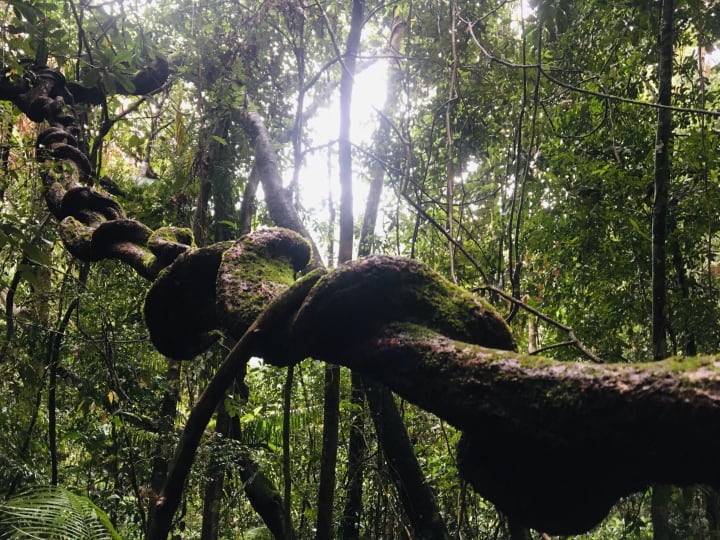
Near Kodimale, there is a 200–300-year-old huge indigenous liana known as "Pus wela" (Entada pusaetha). It is a decorative liana that improves the forest's value and aesthetic appeal. Massive Pus Wela (Entada pusaetha).
Lover’s walk

This is the winding, road through the tall, shaded woods that circles the royal pond. It is well known among young people who come to this woodland to take in its calming natural beauty. A beautiful creation of nature is the cool, shaded area next to the pond and under the dense tree cover.
The pond

During the reign of King, the Queen and other members of the royal family enjoyed water sports on this pond. People think that the bottom of this pond has a golden jar filled with King Keerthi Sri's riches. They also think it appears on the pond's surface once a year, then vanishes. Folklore claims that the individuals who had repeatedly tried to remove the pot had drowned. Many people think that a tunnel leads from the Kandy Lake's center to this pond.
The Marble Seat
Within the woodland stood a flat marble rock. The royal family utilized here as a resting area when they visited the forest to take in its natural beauty. In recent times, it has been taken from that location and housed within the Sri Dalada Sylvan as a flower offering alter.
Best Time to Visit
The ideal times to visit Sinharaja Forest Reserve are from January through March and from August through September. When it rains at this time, it won't significantly interfere with your touring. Sinharaja Forest Reserve gets rain all year round because it is a rainforest and is situated in the Lowland Ecoregion. It is not advised to travel during the peak monsoon season in November and December. The path becomes muddy after heavy rain.

How to get
The Sinharaja Forest, which is situated between the tributaries of the Kalu Ganga in the North and the Gin Ganga in the South, is made up of a number of continuous ridges that are roughly lined in an East-West direction: The four primary entrances to Sinharaja are as follows. the Hiniduma- Neluwa road from the south-west; the Kalawana-Weddagala road from the northwest; the Rakwana-Morning side estate road from the north-east; and the Deniyaya- Pallegama road from the south-east. The Kalawana-Weddagala road is the shortest and most practical route for visitors coming from Colombo.
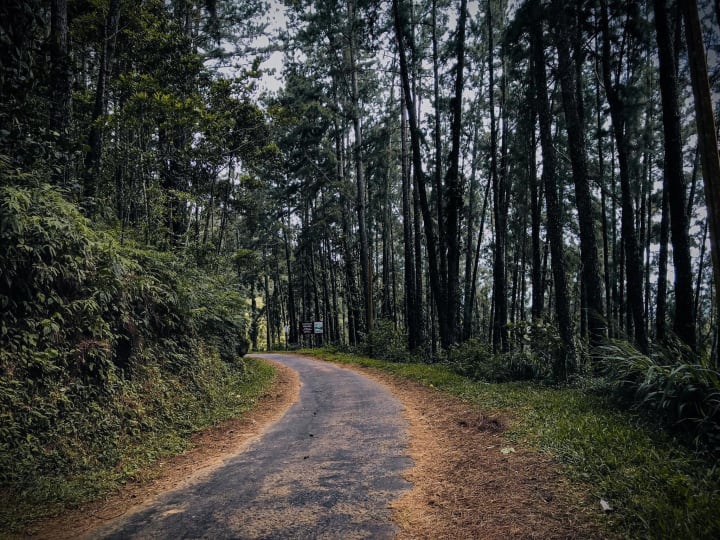
Places to visit
- Maduwanwela Walawwa

The Maduwanwela Disawe, often known as "the Dark Prince of Ceylon," was a figure who embodied an age. The colonial authorities of his day were so influenced by him that they even gave him the title of Sir James William. The Maduwanwela Walawwa, his family mansion, is both a representation of the Disawe's character and a symbol of bygone architecture.
In between Embilipitiya and Suriyawewa is the town of Kolonne. With rice fields and huge trees that stretch out across the plains and offer much-needed shade, it is a place of serene beauty. On a bright, sunny day when we visited Maduwanwela Walawwa, the activity of a farmer's market and the laborers in the rice field brought the hamlet to life in vibrant colors and tones.
The Walawwa was constructed in the 1700s under the direction of the Maduwanwela dynasty and is situated on a portion of the 82,000-acre estate that two Sinhalese monarchs contributed. Kings Raja Singhe II gave Maduwanwela's great ancestor the 54,000-acre Panamure estate (nindagama) in exchange for bringing him the head of a general who was serving the Portuguese.
- Neluwa Duwili Ella Falls
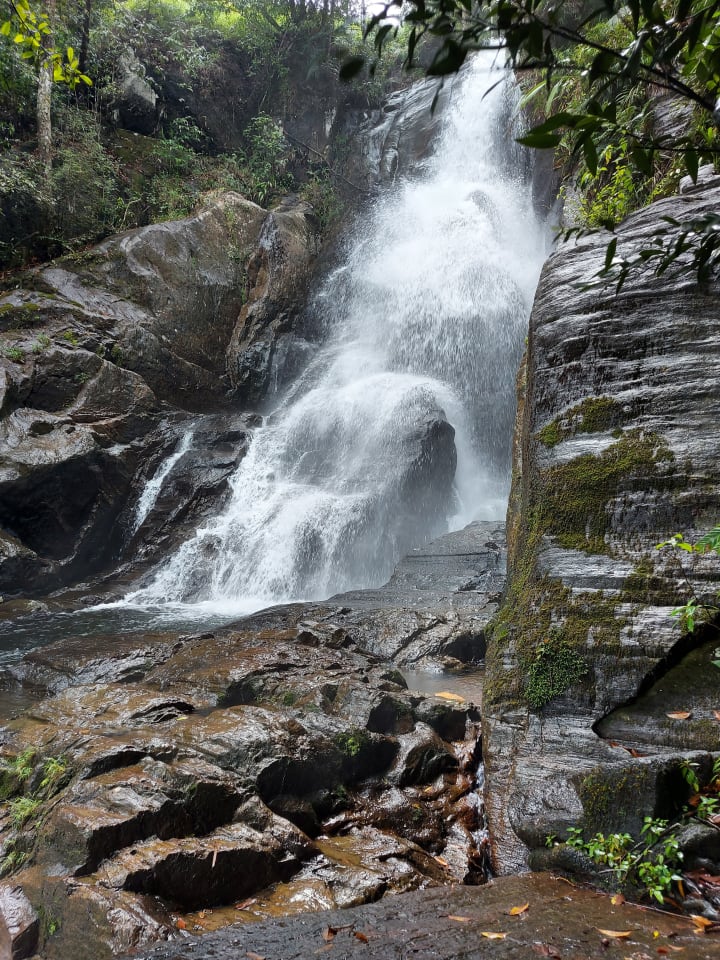
There are 19 waterfalls in the Sinharaja Rain Forest, 11 of which are in the Galle District. Pathanoya Falls, Suduwalikotha Falls, Brahmana Falls, Hathbinna Falls, Malmora Falls, Neluwa Dowili Falls, Wathugala Falls, Lankagama Kekuna Falls, Nellugolla Falls, and Beraliya Dola Falls are among them.
The Neluwa Dowili Falls, which are located around 8 kilometers from the Neluwa town, are one of the most well-known waterfalls in this region. The fall is 1 m broad and 17 m tall. A common term for waterfalls that produce a hazy environment that resembles a dust cloud near the bottom is "Dowili," which means dust. The village or municipality where the fall is located is therefore included as a unique identifier for each Dowili fall. Neluwa Dowili Falls are now known as this fall.
This fall is a well-liked tourist spot for both domestic and foreign visitors, and it is situated in the region of Kosmulla on the way to Lankagama. This fall's surroundings are kept up properly, and steps have been constructed to go to the top of the falls. There are three ways to look at this season. The first leads to the bottom of the higher fall, while the second leads to the lower fall (where the first picture was shot) (where the 2nd photo was taken). The summit of the fall is also reached by the same steps.
The water from the stream is diverted to create two sizable bathing pools at the base of the falls. The first one is kid-friendly and superficial. The second one is slightly safer and deeper. The area is beautifully manicured, and changing rooms are also available. A gate prevents people from entering the pool, and there is a nominal entrance fee (Rs 30) each person. It's open from nine until five.
- Sathmala Ella

In the Matara district, Hathmale Ella Falls is located around 8 kilometres from Deniyaya town. Both its height and width are 45 meters. Sathmala Ella, which translates to "seven segmented falls," is another name for the waterfall. The Deniyaya Gonagala Mountain is where Hathmale Ella Falls originates. The Ginganga River receives the water flow.
Bypassing Akuressa, Pitabeddara, Morawaka, and Kotapola on the Galle-Deniyaya-Madampe Road will get you to Deniyaya. To get to the Hathmale Ella Falls, use the Deniyaya-Pallega Road and then turn into the Hathmale Ella Road.
- Patna

In the Pallegama region of Deniyaya, Patna is a magnificent location situated in the center of a tea farm. The Deniyaya region is highly well-liked by tourists due to its biodiversity and attractiveness. As a result, Patna is a location where you risk slipping while on the water. often referred to as brush stone
Additionally, Patna has a gorgeous scenery. This area has a sizable boulder that is a little bit slick and slippery. It has the impression of sliding down a seso. The Deniyaya region is highly well-liked by tourists due to its biodiversity and attractiveness.
To experience this great natural experience, Patna draws a lot of tourists. This area, which was naturally generated by a stream flowing down the Gin River, may be experienced by a huge group of people at once, and as you're traveling downward from here, you can witness a number of waterfalls. With the group, you may climb the rock, slide along the rock, and enjoy the water pipes.
- Pusma Ella Waterfalls

Deniyaya is a paradise of waterfalls and there’re beautiful waterfalls not far from Deniyaya. Pusma Ella waterfall is the beautiful of all of them & it’s located at Higurahena. You need a special permission to camp near that waterfall. It’s a remarkable memory of your travelling life.
Protection
The majority of the land was declared a forest reserve on May 3rd, 1875, beginning a lengthy history of preservation. On October 21st, 1988, it was named a wilderness area of national significance. The National Heritage and Wilderness Area Act of Sri Lanka provides the property with the greatest degree of legal protection, and practically all of the surrounding natural forests have already been declared as conservation or reserved forests under the Forest Ordinance. When the site was named a Biosphere Reserve in April 1978 and later added to the World Heritage List, it’s worth was further acknowledged.
The Divisional Forest Officer of the Forest Department, who answers to the Ministry of Lands and Land Development, oversees the management of the Sinharaja World Heritage site directly. A National Steering Committee oversees the institutions for Sinharaja as a National Wilderness Area, Biosphere Reserve, and World Heritage site. According to the guidelines of the corresponding management plans, which were created for the Sinharaja Conservation Area and the property's surrounding natural forests in accordance with national forest policy directives, management activities and research are carried out. The property's management plans, which were created in 1985–1986, and 1992–1994, respectively, emphasize conservation, community involvement, buffer zone management, scientific testing, and benefit-sharing.
The National Heritage Wilderness Area Act provides the maximum level of legal protection for Sinharaja, and the high level of environmental consciousness in the neighborhood greatly facilitates the implementation of management plan recommendations. The forest is not heavily used by neighboring populations, and preserving this positive relationship with them is the major method for guaranteeing the property's continued protection. The Forest Department gives priority to protecting the reserve above pressure from development and resource extraction because of its inaccessibility and steep, rocky terrain. With only permits allowed admission, there are still few visitors.

The biggest danger to the integrity and values of the land is encroaching agriculture, especially along the southern boundary. Through road developments, which create pathways and access points onto the land and facilitate illicit forestry and resource extraction, as well as posing a threat from illegal gem mining, outside development has an indirect influence on the site. The conventional uses of forest products are currently only permitted beyond the borders.
Lack of funds and insufficient people make it difficult to administer the region effectively over the long run. The management organization, Sri Lankan Forestry Department, has given management of Sinharaja great priority and has allocated funding in accordance with the objectives indicated in the management plan and current management initiatives.
Google Map:
About the Creator
Zeloan
I'm a Traveller, Blogger, and Content Creator. Visit Sri Lanka, and you can see the most beautiful places in the world and the remarkable hospitality here






Comments
There are no comments for this story
Be the first to respond and start the conversation.